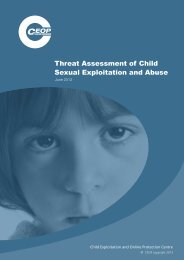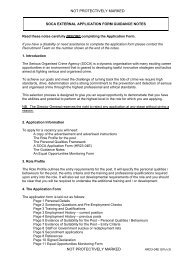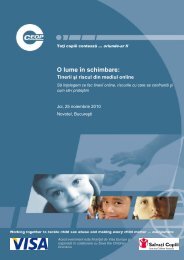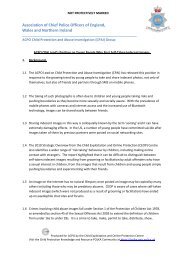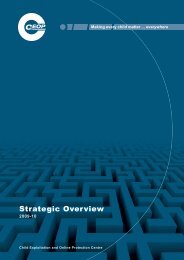Threat Assessment of Child Sexual Exploitation and Abuse - Ceop
Threat Assessment of Child Sexual Exploitation and Abuse - Ceop
Threat Assessment of Child Sexual Exploitation and Abuse - Ceop
You also want an ePaper? Increase the reach of your titles
YUMPU automatically turns print PDFs into web optimized ePapers that Google loves.
Section 3 Priority Themes<br />
5. Group <strong>and</strong> gang associated child sexual exploitation (GGACSE)<br />
Whilst CEOP’s underst<strong>and</strong>ing <strong>of</strong> group <strong>and</strong> gang associated child sexual exploitation (GGACSE) is growing, the full nature<br />
<strong>of</strong> scale <strong>of</strong> the threat from this type <strong>of</strong> <strong>of</strong>fending is not yet fully understood. One <strong>of</strong> the reasons for this is that victims,<br />
particularly those from vulnerable groups, <strong>of</strong>ten disengage from protective services as a result <strong>of</strong> their grooming <strong>and</strong><br />
exploitation. Awareness <strong>of</strong> these forms <strong>of</strong> child sexual exploitation has increased markedly in recent months with<br />
a number <strong>of</strong> police investigations attracting significant media coverage.<br />
CEOP’s thematic assessment ‘Out <strong>of</strong> Mind, Out <strong>of</strong> Sight’ published in 2011 found that whilst group associated sexual<br />
exploitation is taking place across the UK, much <strong>of</strong> it falls below the radar <strong>of</strong> the authorities. The assessment set out to<br />
draw on the experiences <strong>of</strong> police forces, NGOs, academia <strong>and</strong> victims to identify patterns in <strong>of</strong>fender <strong>and</strong> victim pr<strong>of</strong>iles<br />
<strong>and</strong> <strong>of</strong>fending methodologies. The aim was to inform investigative <strong>and</strong> educational responses to the threat.<br />
Whilst there are many common characteristics shared by both types <strong>of</strong> <strong>of</strong>fending, such as the age <strong>and</strong> vulnerability<br />
<strong>of</strong> victims, group <strong>and</strong> gang associated exploitation are two distinct typologies. In group associated sexual exploitation,<br />
<strong>of</strong>fending generally takes place within loose networks, connected through formal <strong>and</strong> informal associations. This can be<br />
distinguished from gang associated exploitation where <strong>of</strong>fenders see themselves, <strong>and</strong> are seen by others as affiliates <strong>of</strong><br />
a named criminal group, with distinctive beliefs, attitudes <strong>and</strong> behaviours. The sexual exploitation <strong>of</strong> children within a gang<br />
setting can be accompanied by levels <strong>of</strong> violence not generally seen in group associated <strong>of</strong>fending.<br />
This type <strong>of</strong> child sexual abuse is complex with the causes, behaviours <strong>and</strong> motivations <strong>of</strong>ten very difficult to untangle.<br />
Those victims who have disclosed have been vulnerable <strong>and</strong> under social, financial <strong>and</strong> economical pressures. Some have<br />
taken to leaving home or have gone missing whilst in local care arrangements, opting or being coerced into informal income<br />
as a means to get by. Others have not considered themselves as victims at all, having been normalised to sexual violence.<br />
Those within gangs have endured sexual exploitation for the inclusion <strong>and</strong> perceived protection afforded by their gang.<br />
There is little demographic data available which helps in predetermining GGACSE <strong>of</strong>fenders or victims. In those cases <strong>of</strong><br />
which CEOP is aware, the <strong>of</strong>fending is predominantly male against female although there are a small number <strong>of</strong> exceptions.<br />
Ethnicity is one area which has received high pr<strong>of</strong>ile media attention as a result <strong>of</strong> recent convictions. Data currently suggests<br />
that a disproportionate number <strong>of</strong> <strong>of</strong>fenders are British Asian, particularly British Pakistani, males. However, more work needs<br />
to be done with a broader set <strong>of</strong> data to better underst<strong>and</strong> whether any correlation exists.<br />
The recent convictions highlight the need for all those who come into contact with children to be aware <strong>of</strong> the possible signs<br />
<strong>of</strong> GGACSE <strong>and</strong> for a multi agency intervention to take place as soon as possible. CEOP remains committed to working with<br />
partners across the country to fill gaps in our current knowledge <strong>of</strong> this <strong>of</strong>fending <strong>and</strong> the role <strong>of</strong> schools, police, children’s<br />
services <strong>and</strong> health agencies cannot be understated. Such <strong>of</strong>fending is a key priority for CEOP in 2012/13.<br />
Key findings<br />
<strong>Threat</strong> <strong>Assessment</strong> <strong>of</strong> <strong>Child</strong> <strong>Sexual</strong> <strong>Exploitation</strong> <strong>and</strong> <strong>Abuse</strong> 2012<br />
8 The scale <strong>and</strong> nature <strong>of</strong> GGACSE remains undefined, but is happening across the UK. Victims must be<br />
encouraged, <strong>and</strong> have the confidence to engage with protective services.<br />
8 In the majority <strong>of</strong> cases, networks <strong>of</strong> male <strong>of</strong>fenders are targeting female victims with social, financial or<br />
economical vulnerabilities.<br />
8 Greater awareness <strong>of</strong> GGACSE among frontline services is needed to identify potential victims.<br />
8 Appropriate multi agency interventions <strong>and</strong> support services should be put in place for the victim as soon<br />
as possible.<br />
13



